How to Make Preserved Lemons
Moroccan preserved lemons are salty with mouth-puckering citrusy goodness. This recipe shows you how to make preserved lemons at home with only lemons and salt. And some patience. But they keep in the fridge for months!
I adore all things citrus. My childhood memories are filled with the smell of orange blossoms and the lingering scent of just-picked lemons. And these salty, mouth-puckering Moroccan preserved lemons are just pure citrusy goodness.
Their culinary use stretch well beyond the Moroccan tagines we associate them with. They make excellent salad dressings, marinades and infused oils. Or add them to aioli like Yotam Ottolenghi does. You can even add a splash of the salty, citrusy brine to your next gin and tonic – you can thank me later.
This post shows how to make preserved lemons with only two ingredients – lemons and salt – in three easy steps.
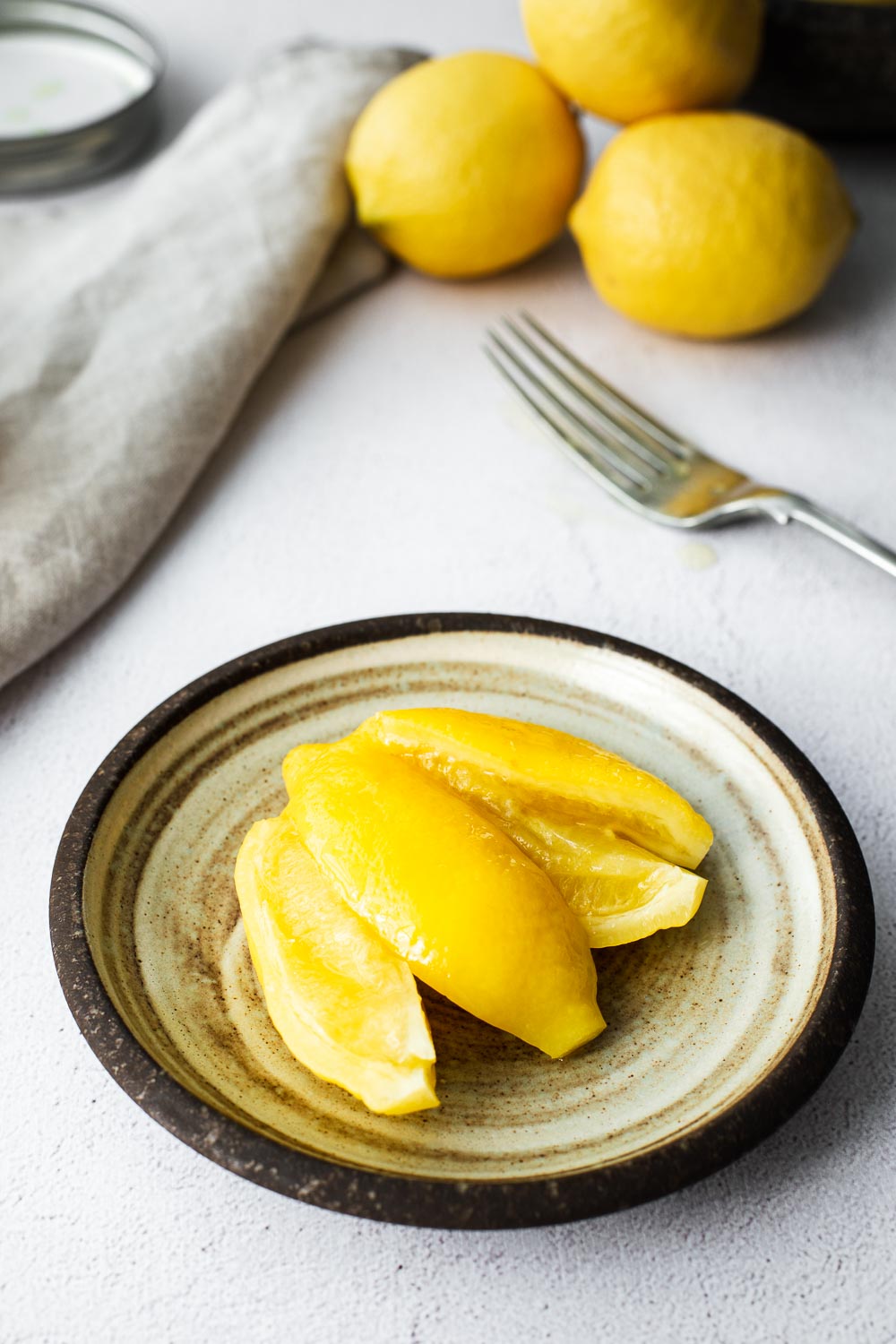
What are preserved lemons?
There are different versions of preserved lemons across North Africa and Asia. For example, Morrocan lemons are preserved in their own juice, while Vietnamese Chanh Muối is made with a water-based pickling brine. Even within Morocco, there are different methods for preserving lemons in their own juice.
My favourite is Moroccan preserved lemons made with only lemons and salt.
Traditional Moroccan preserved lemons
There are many cookbooks and blogs with instructions for making preserved lemons. And I’m pretty sure they’re all delicious. Because lemons, remember?
While there is a lot to love about Yotam Ottolenghi and Sami Tamimi’s recipe in Jerusalem (like the added rosemary and chillies), it is the simplest recipe that I keep going back to. Lemon and salt, that’s all you need.
This recipe is adapted from the instructions in Casablanca: My Moroccan Food by Nargisse Benkabbou. It is my favourite book for all things Moroccan food. Nargisse uses the traditional Moroccan salt-preserving method. No added herbs, no oil, just unadulterated salty, lemony goodness.
This appeals to me because – again, just in case you have not noticed – I absolutely adore lemons. Besides, you can always add more aromatics when using the preserved lemons in cooking.
Preserved lemons and botulism
Yes, I know. I used the b-word, but I saw this concern listed on several forums while researching the topic. Moroccan preserved lemons are safe from botulism. This specific method for salt-preserved lemons creates an inhospitable environment for the harmful botulism toxin.
Three reasons why salt-preserved lemons are safe from botulism
- Lemon juice is very acidic – it has a pH between 2 and 3. We create an inhospitable environment for bacterial growth by using lemon juice as the pickling liquid for traditional preserved lemons. Just think of how many commercial products include citric acid as a preservative.
- This method uses no oil to cover the lemons. The invisible bacteria flourish in an oxygen-free environment – which this is not.
- There are no additional herbs or spices. The spores – that eventually lead to bacteria and toxins – can contaminate plant-based material.
There is more you can do to keep your preserved lemons free from any harmful bacteria. These tips apply to other pickles and ferments too.
How to store preserved lemons
Storing preserved lemons correctly is essential to keep them free from mold and bacteria.
- Store your preserved lemons in the fridge once opened.
- Ensure that they always remain covered by the pickling juice. You can top up with a sprinkling of salt and more fresh lemon juice if any lemons are poking out.
- Use clean utensils to remove lemons from the jar instead of your finger. I find that chopsticks work great.
Follow these instructions, and this is the safest home preserve out there – the perfect home project to get you hooked on preservation and fermentation.
Which lemons are best for preserving?
In Morocco, they use Doqq or Boussera lemons – also referred to as Citron Beldi and Limonette de Marrakech. Both varieties are small round lemons with thin, fragrant skin and sweet flesh.
Unfortunately, these varieties are not widely available. In the US, Meyer lemons are a popular choice for preservation. They’re a cross between lemons and mandarins, and their skin is said to have floral hints while the flesh is sweet but still distinctly lemony.
At home, none of these options is available. So, I use the seedless LemonGold variety. They are seedless and very juicy. But you can also use the standard Eureka or Lisbon variety.
You can add a few strips of mandarin zest and a tablespoon of mandarin juice for a bit of citrus sweetness if you use standard Eureka lemons.
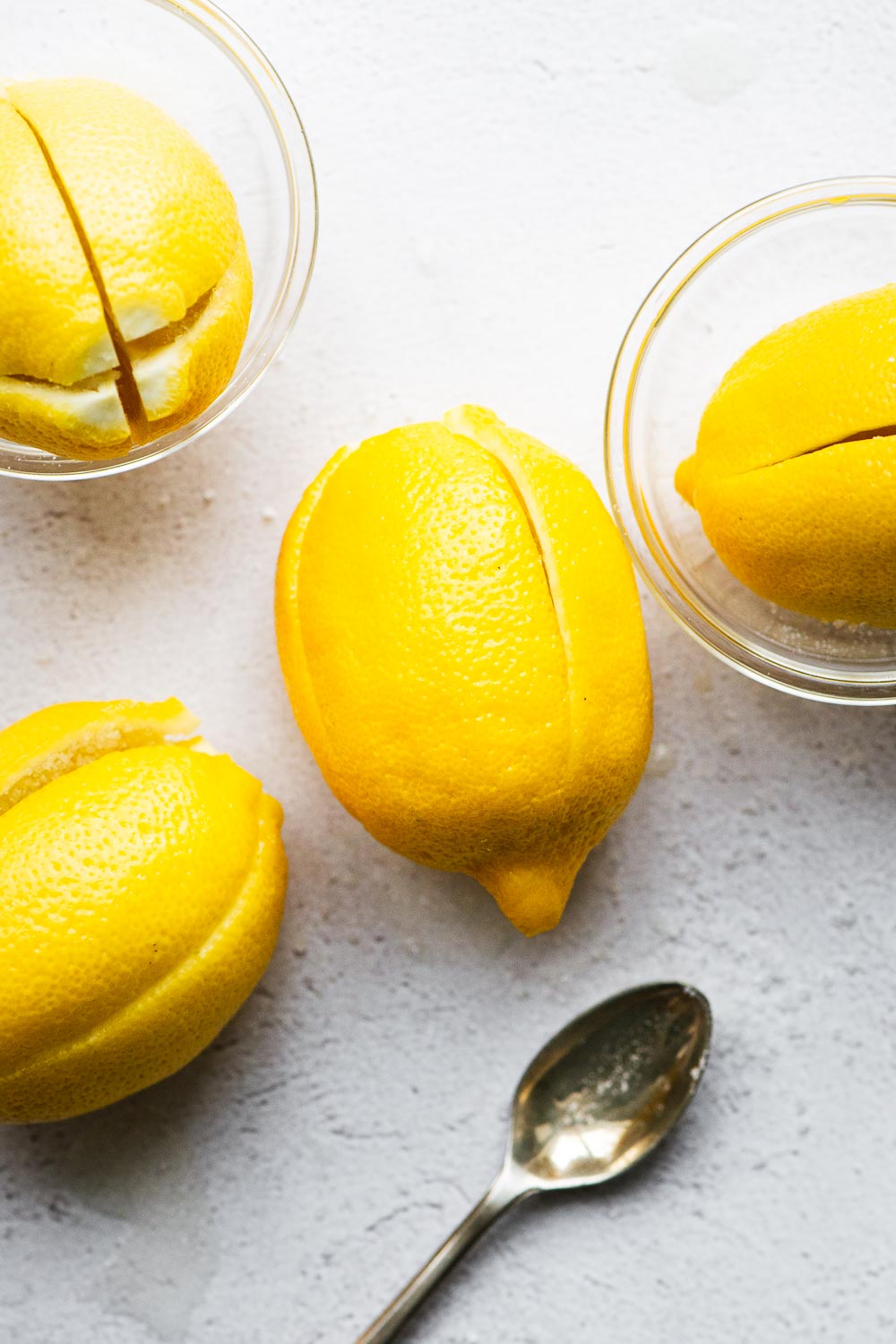
How to make preserved lemons in three easy steps
Making preserved lemons at home could not be easier. You only need two ingredients – lemons and salt – as well as some patience.
This recipe calls for 8 lemons (plus more for the fresh lemon juice), but the recipe scales well. Use however many lemons will fit in your jar, and add two to three teaspoons of salt for each lemon – depending on their size.
Sprinkle each jar with an additional two teaspoons of salt before covering with fresh lemon juice – just remember to reserve a few lemons for the fresh juice.
Step 1: Salt the lemons
Rinse the lemons. Then take each lemon and cut off any leftover bit of stem – including the little lemon tail where it was attached.
Make two perpendicular lengthwise cuts in the lemon without slicing all the way through – as though you want to cut the lemon into quartered wedges, except you stop about 2 cm short of the end.
Gently open the quarters and fill each lemon with roughly 2 teaspoons of salt (or 3 teaspoons for large lemons). Close up the quarters to reshape the lemon.
Step 2: Pack into clean jars
Use a glass jar with a tight-fitting lid. Pick one that is big enough to very tightly fit all of the lemons.
For 8 medium-sized lemons, I use a 1 litre (quart-sized) glass jar or two smaller jars (with 4 whole lemons each). Smaller containers are easier to store. And you can start using one container after 4 weeks while you let the second batch of lemons mature more.
There are many different ways to sterilise glass jars at home. See this post by The Spruce Eats for three ways to sterilise your glass jars. I find the microwave method to be the most convenient.
Pack the lemons into the jar as tightly as possible. Use a wooden spoon or muddler to gently press down on the lemons so that they release some of their juice. Sprinkle a final two teaspoons of salt over the top of the lemons.
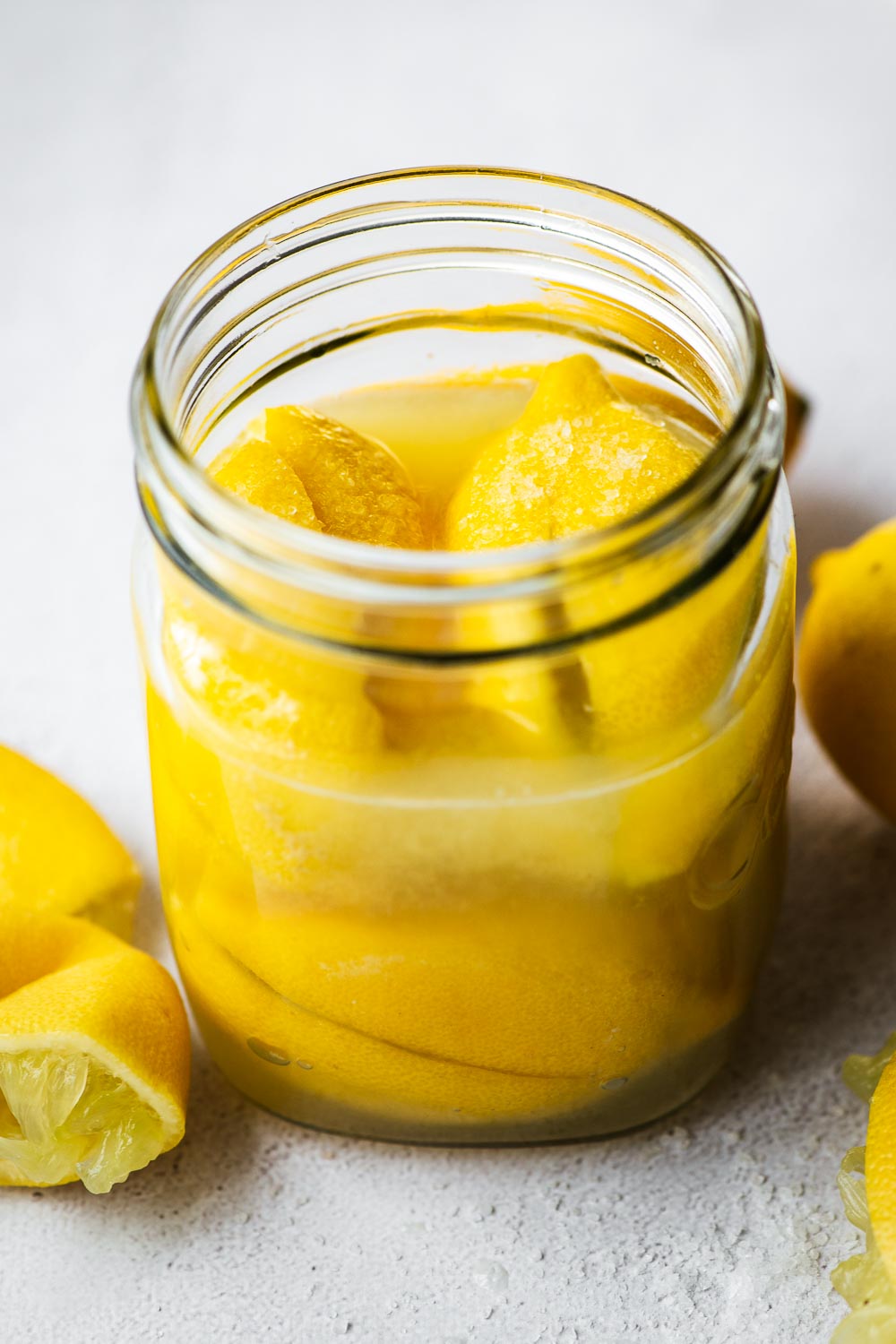
Finally, top up with as much fresh lemon juice as needed to completely cover the lemons. If you have standard Eureka lemons, you can also add the juice from one mandarin to sweeten things up a bit.
Waste Not Tip: Before juicing lemons, remove the zest and add it to a small jar with flaky sea salt. Set aside to infuse for a week or so. Sprinkle your citrus salt on salads, veggies, or your weekday boiled eggs. See how to make dried lemon zest for more details.
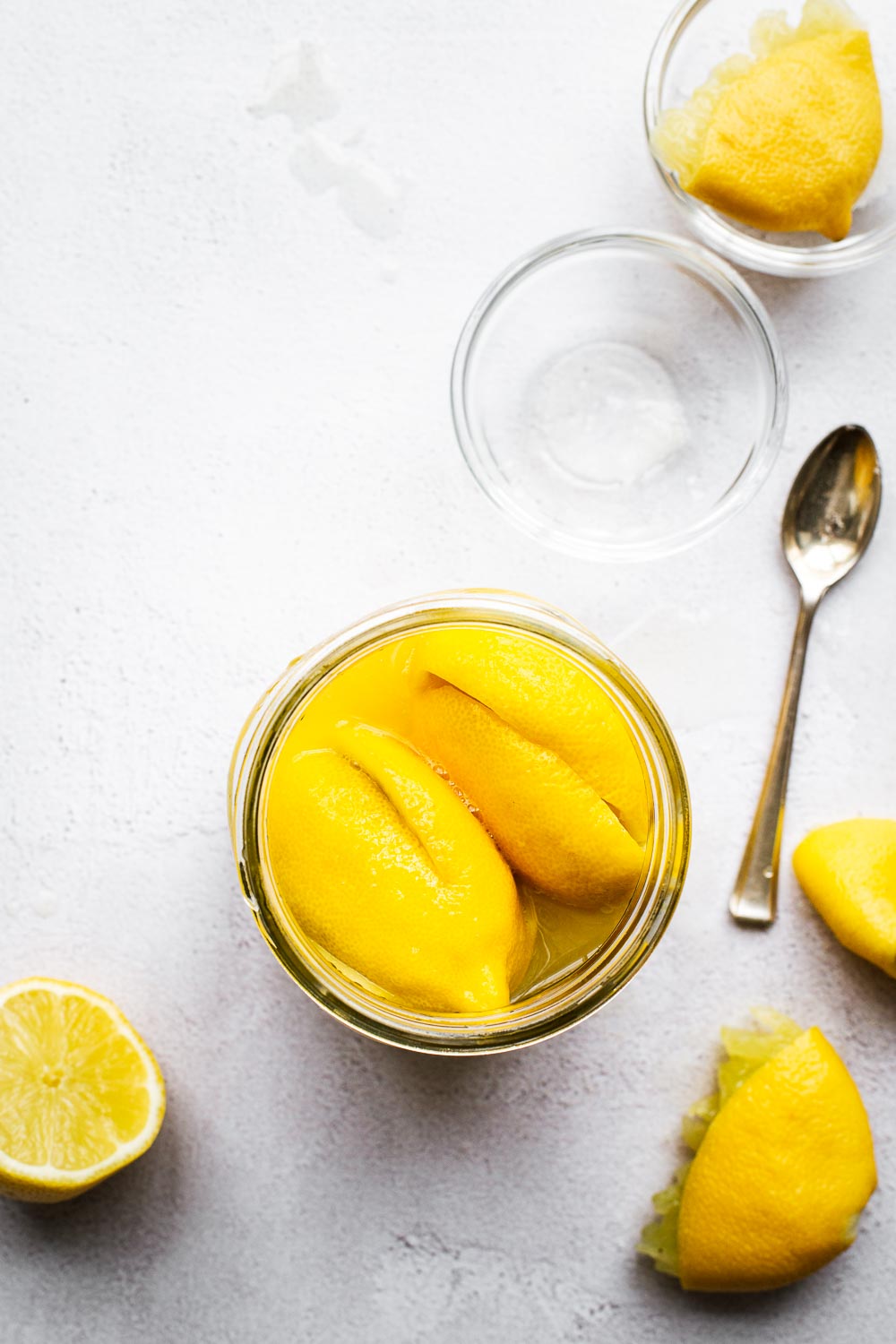
Step 3: Leave to mature
Seal the jar and place it in a cool, dark place. Flip the jar upside down once a week to ensure that your lemony brine is evenly distributed.
Over time, the rinds soften and the flavour intensifies. The preserved lemons are ready after 4 weeks though you can leave them even longer. They will lose their vivid yellow colour, but the taste will intensify.
Once you are happy with the softness and flavour of your preserved lemons, move the jar to the fridge. It will keep for up to 1 year.
While the acidic, salty brine is not a suitable environment for bacteria, it is best to avoid introducing any contaminants. Use clean utensils (that are not fingers) to remove the lemons from the jar. Chopsticks are perfect for this.
How to use preserved lemons
You can use the rind, the pulp and the syrupy preserving liquid, though most recipes require only the rind.
When I follow a recipe that requires only the rind, I reserve the pulp to make a quick marinade/dressing. Use a pestle and mortar to bash it with a garlic bulb and a pinch of brown sugar (or honey), and top with olive oil.
Paula Wolfert, the author of Couscous and other good food from Morocco, reuses the pickling liquid for her next batch of preserved lemons.
Preserved lemons are also used in Middle Eastern cooking, making Yotam Ottolenghi an excellent source of recipes featuring preserved lemons.
Two of my favourite preserved lemon Ottolenghi recipes are:
- The preserved lemon mayonnaise that he serves with a beautiful artichoke salad.
- The preserved lemon, chilli and herb oil from Ottolenghi Test Kitchen: Shelf Love. Get the full recipe for butter beans with preserved lemon, chilli and herb oil or see my quick summary of the preserved lemon, chilli and herb oil below.
Noor Murad and Yotam Ottolenghi’s preserved lemon, chilli and herb oil
This oil is inspired by the flavours of the Mediterranean. It’s a wonderful example of the versatility of preserved lemons.
Ottolenghi and Murad use this oil to marinade butter beans, but you can really use it for anything.
Drizzle the oil over just-cooked veggies such as broccoli or cauliflower. Use it to marinade any other pulses, like lentils and chickpeas. Or simply spoon it over hummus or labneh and serve it with loads of fluffy flatbread.
I adapted the recipe slightly to suit what I had available. But do check out the original recipe online. Or even better, buy their book, Ottolenghi Test Kitchen: Shelf Love!
Mix 5 crushed garlic cloves, a teaspoon of smoked chilli flakes, 1 tablespoon of coriander seeds, 5 tablespoons of chopped preserved lemons (rind only), 1 tablespoon of fresh thyme leaves, 4 rosemary sprigs, 1 tablespoon tomato paste and 1½ cups olive oil with some flaked salt in a saucepan and place it on medium-low heat.
Allow this mix to gently heat for 25 minutes until fragrant, but not coloured (you don’t want bitter burnt garlic to overshadow the preserved lemons). And just like that, your oil is ready to use.
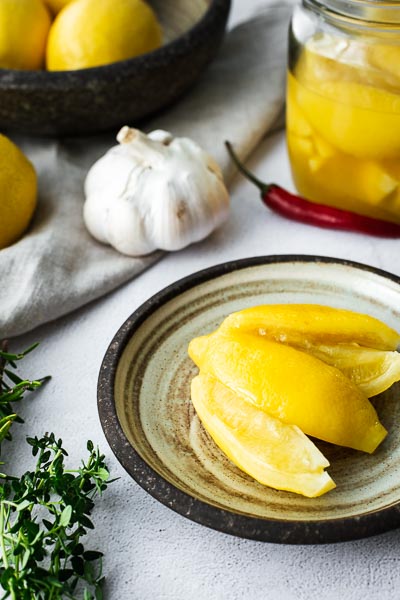
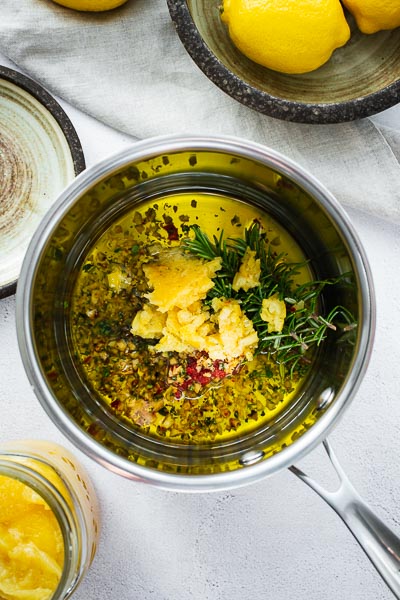
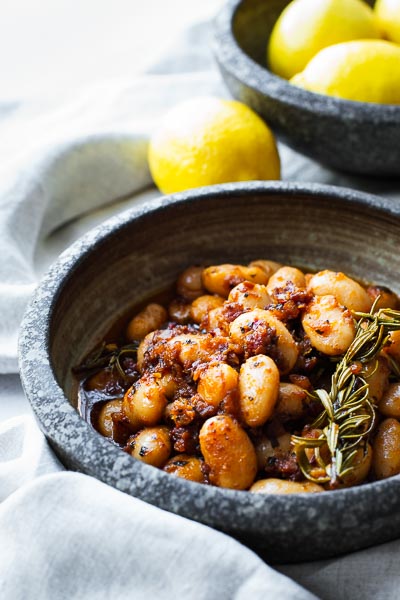
Or try this simple marinade for any roast veg:
- Mix 3 tablespoons of chopped preserved lemon rind with 2 tablespoons of fresh lemon juice, 2 tablespoons olive oil and some chopped green herbs.
- I also love to add 2 tablespoons of capers, rinsed and chopped.
- Use this marinade to coat any just-roasted veggies while they are still warm.
- Or use this versatile mix as a salad dressing.
Related Recipe: Charred broccolini with preserved lemon & caper dressing
Turn the leftover pulp and juice into preserved lemon pureé
Whenever a recipe calls for only the preserved lemon skin, I carefully pull the skin from the citrus flesh using chopsticks or other clean utensils – not my hands. I leave the lemon flesh or pulp in the jar until there is only one preserved lemon, some pulp and preserved lemon juice remaining.
How to make preserved lemon pureé
Remove any visible seeds by fishing them out with a clean spoon.
Blitz everything together with a stick blender (immersion blender) until you have a smooth preserved lemon pureé. Return the pureé to the same vessel, or transfer to a smaller sterilised jar to free up some fridge space.
How to use preserved lemon purée
Mix the pureé with tahini and a splash of water for a lemony tahini sauce.
This preserved lemon pureé is super handy to boost umami and acidity in dressings, stews and drinks without any need for chopping– as in this kale quinoa salad.
Related Post: Quinoa, kale, chickpea and avocado salad with preserved lemon dressing
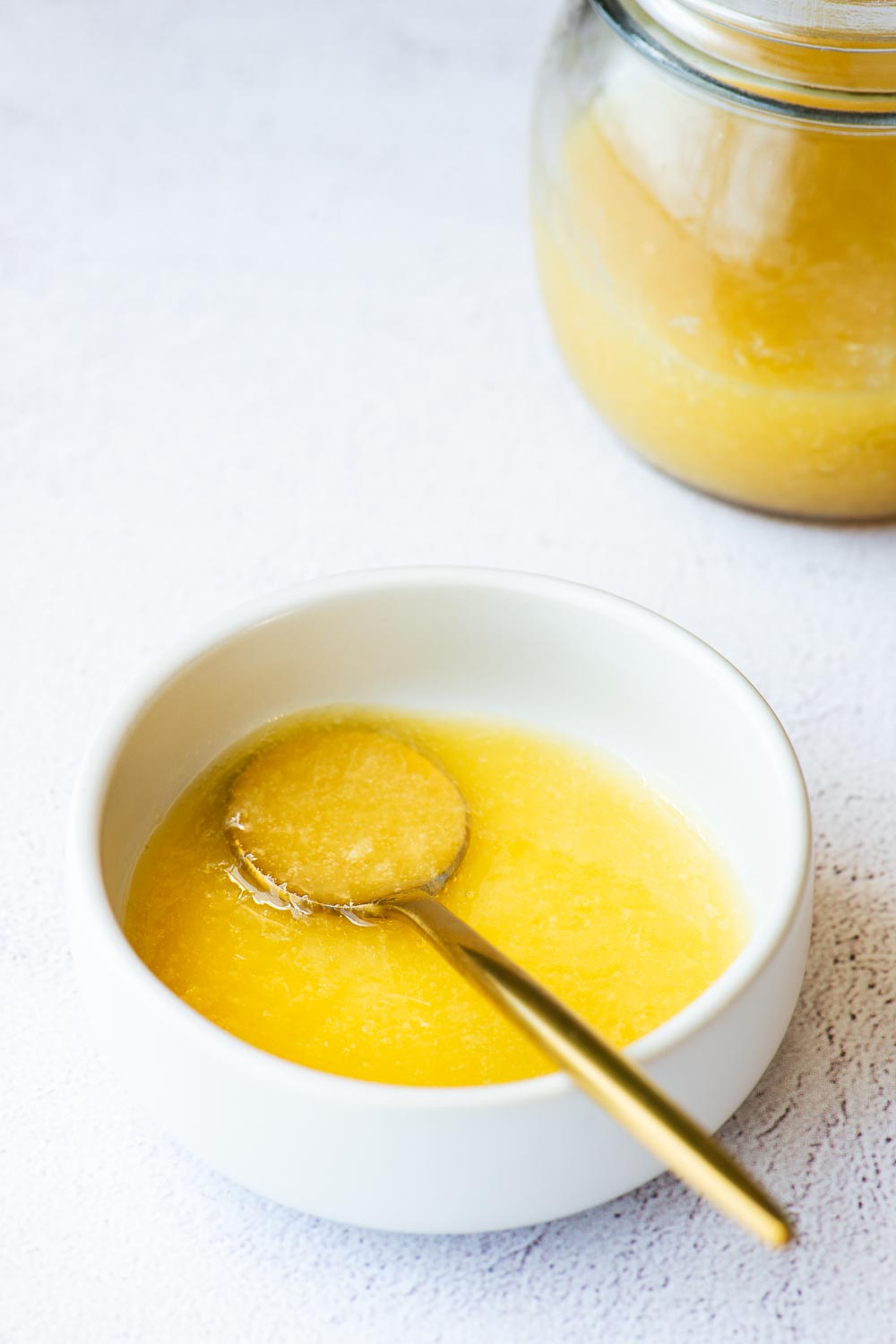
Frequently asked questions
I try to anticipate all of your preserved lemon questions here. Please leave a comment below if I missed anything!
Why use preserved lemons instead of fresh ones?
The preserved lemon flavour intensifies as their skins soften with time. They have a bright, savoury flavour – or umami – that fresh lemons don’t have. You can blitz the whole preserved lemons into a delicious preserved lemon pureé that is always ready to be scooped out.
What is a quick and easy preserved lemon substitute?
Moroccan preserved lemons are easy to make, but they need at least four weeks to mature. So, in a pinch, you can use a mix of fresh lemon zest, juice and salt as a preserved lemon substitute. Mix the juice and zest of 1 whole lemon with 1 teaspoon of ground salt. See more preserved lemon substitutes.
What are preserved lemons good for?
Preserved lemons add a brightly acidic, savoury depth to North African tagines and stews. Add the skin, pulp or pickling juice to any dressings and sauces that need acidity and umami.
Do you eat the skin of preserved lemons?
Yes, absolutely! The skins soften and intensify in flavour the longer they are preserved. They are the best part of the preserved lemon, and some recipes require only the skins. Keep the juice for dressings and drinks, or reuse it for your next batch of preserved lemons.
Can you use the juice from preserved lemons?
Yes! You can reuse the remaining pickling juice for your next batch of preserved lemons. But the juice from preserved lemons is also great to add to salad dressings, sauces and even cocktails.
Can you use the pulp of preserved lemons?
Many recipes only call for the skin of the preserved lemon, but you can go ahead and include the pulp of the preserved lemon too. Or reserve the pulp to muddle into drinks. I often return them to the preserved lemon jar – using clean chopsticks to avoid contamination – and use them later as needed. See how to turn leftover pulp and juice into preserved lemon pureé.
These Moroccan preserved lemons are so easy to make. You really should give it a go! They will only be ready in a minimum of four weeks, so best to start today!
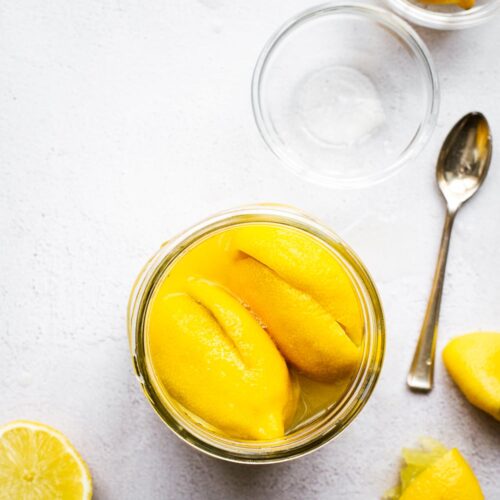
Equipment
- A sterilised glass jar with a tight-fitting lid – large enough to hold all the lemons snuggly. I use a 1 litre (quart-sized) jar (or two smaller ones).
Ingredients
- 8 lemons, washed (see notes)
- 18 teaspoons salt, or more for large lemons
- ½ cup freshly squeezed lemon juice, or as much as needed to cover the lemons completely
Instructions
- Take each lemon and cut off the leftover bit of stem. Make two perpendicular lengthwise cuts in the lemon without slicing all the way through – like you want to cut the lemon into quartered wedges, except you stop about 2 cm short of the end.
- Gently open the quarters and fill each lemon with roughly 2 teaspoons of salt (or 3 teaspoons for large lemons). Close up the quarters to reshape the lemon.
- Make sure your sterilised glass jar(s) are squeaky clean. It needs to be large enough to fit all the lemons. I use a litre (quart-sized) jar, or sometimes 2 smaller jars. The smaller containers are easier to store in the fridge.
- Pack the lemons into the jar as tightly as possible. Use a wooden spoon or muddler to gently press down on the lemons so that they release some of their juice. Sprinkle a final two teaspoons of salt over the top of the lemons. Top up the jar(s) with enough fresh lemon juice to cover the lemons to avoid exposure to air.
- Seal the jar and place it in a cool, dark place. Flip the jar upside down once a week to ensure that your lemony brine is evenly distributed.
- The preserved lemons are ready after 4 weeks though you can leave them even longer. Once you are happy with the softness and intensity of your preserved lemons, move the jar to the fridge. It will keep for up to 1 year.
Notes
- Standard Eureka lemons are not as sweet as traditional Moroccan lemons. Use Meyer lemons if you can find them, or add the juice of one mandarin to the pickling liquid. Just make sure the mixture is still plenty acidic. Both for flavour and protecting against bacteria.
- Use clean, sterilised containers to preserve the lemons. Here are three ways to sterilise glass jars.
- Clean wooden utensils – like chopsticks or a spoon – works best to remove preserved lemons from the jar. This way, you can avoid introducing any bacteria from your hands.
- You can use the rind, the pulp and the syrupy preserving liquid, though most recipes require only the rind. See the full blog post for more ideas to use all parts of the preserved lemon.

This was so easy to make and it was amazing!
Thank you, Sarah! I’m so happy you enjoyed it! 🍋
How long will they last and how do you store them?
Hi Billie,
Once opened, you need to store the jar in the fridge. Always keep the lemons submerged in the lemon juice (you can top it up with fresh lemon juice if they start to poke out). And always use clean utensils when you remove lemons from the jar. Then they’ll last up to a year.
If you make a puree, can you use it in sweet recipes or is it too salty? Thanks
Hi Carol,
My gut feeling is that it will be too salty for most sweet bakes. While it packs a great citrus punch with an almost candy-like lemon flavour, it is significantly saltier than lemon paste typically used in baking.
That said, I personally love a bit of salt to elevate the flavour in both savoury and sweet bakes. So, ultimately it would depend on the type of recipe and the amount of preserved lemon purée you want to add.
Upon investigating this idea, I found a preserved-lemon tea cake recipe on Bon Appétit that actually looks divine (though they do describe it as having a slightly briny flavour). Just note that the preserved lemon in the ingredients list is most likely a Beldi lemon. They’re much smaller than standard lemons, so don’t use a whole homemade preserved lemon in the recipe. I recommend swapping their single preserved lemon for 3 tablespoons of preserved lemon purée if you want to give it a go. I might just make it myself – it looks very much like my kind of tea take!
Do I need to wash the lemon when I take it from the brine or do I use it straight from the jar? Never used them but keep seeing them in recipes so am going to take the plunge
I am so happy that you’re taking the plunge! They pack a salty supercharged lemon flavour. And they’re so convenient because they keep so long. I’m never without an open batch in the fridge and an upcoming batch in the pantry! But back to your question:
There is no need to rinse off the brine – I don’t. But if you find the lemons too salty for your taste, or if the recipe you’re using them in asks for rinsed preserved lemon rind, go ahead and give them a rinse.
Have fun with your preserved lemons!